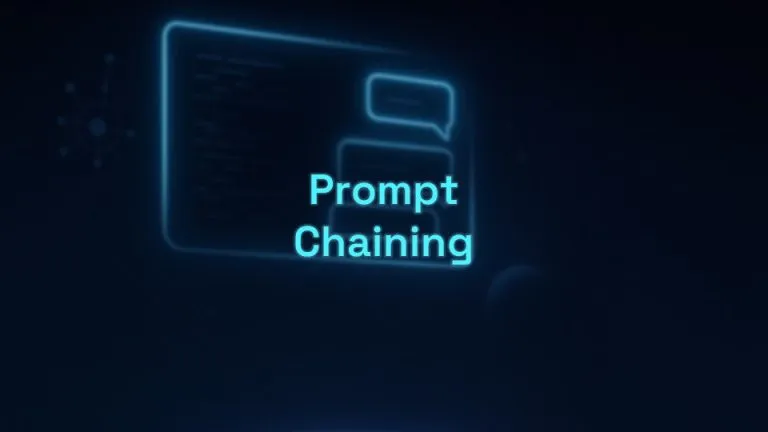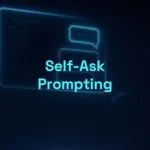Prompt Chaining: Solve Complex Tasks with Chained Steps

Want to handle complex projects with better organization? The Prompt Chaining technique instructs the AI to tackle a task in sequential stages, using the output of one prompt as input for the next. This enables logical and structured resolution of multi-phase problems.
If you’re an end user working on elaborate projects, creative processes, or complex decision-making, learning Prompt Chaining will unlock new strategic possibilities.
This article was created to help end users understand the core concepts, make technical concepts more accessible, and intentionally and explicitly adapt and apply the Prompt Chaining technique in their daily use of AI, without automatically relying on the model’s capabilities. For further technical exploration, see Learn More.
Table of Contents
What Is the Prompt Chaining Technique?
Prompt Chaining is a prompt engineering technique that breaks a complex task into a series of interdependent prompts, where each prompt’s output serves as the input or context for the next. For example, to create a travel plan, the first prompt might generate a list of destinations, the second detail activities in a selected destination, and the third organize a complete itinerary. This modular approach ensures each step is well defined, making it easier to build robust solutions.
The benefits include greater organization, clarity in multi-phase tasks, and the ability to manage complex projects with precision. It’s an accessible technique that empowers users of all levels to achieve structured results, especially in planning, writing, or analysis.
Origin of the Prompt Chaining Technique
Prompt Chaining emerged with the advancement of language models, gaining prominence in 2022–2023 as a method for structuring complex tasks into steps. Inspired by techniques like Chain-of-Thought and Prompt Iteration, it is widely used in tools like ChatGPT, Claude, and Grok, offering a systematic approach to multi-step projects.
How Does It Work?
Prompt Chaining is applied by creating a sequence of prompts, each addressing a specific stage of the task, with the output of one serving as context for the next. Follow these steps:
- Define the overall task: Identify the final goal (e.g., “Create a travel plan”).
- Break it into stages: Divide the task into logical subtasks (e.g., list destinations, detail activities, build itinerary).
- Create sequential prompts: Write prompts for each stage, using the previous output as input for the next.
- Specify formats: Choose clear formats (e.g., lists, paragraphs, tables) to organize each output.
- Review and connect: Ensure outputs connect logically, adjusting prompts if necessary.
Think of it like assembling a puzzle, where each prompt adds a piece until the full picture is complete. You can also iterate—refining outputs or adjusting prompts to ensure coherence.
When to Use It?
Prompt Chaining is ideal for situations that require organization, multi-step tasks, or detailed results. Use it when you want to:
- Manage complex projects: Perfect for structured planning, writing, or analysis.
- Ensure clarity: Great for tasks that benefit from a modular approach.
- Produce detailed outputs: Ideal for creating reports, plans, or comprehensive content.
Practical Examples of Prompt Chaining in Action
See how to apply Prompt Chaining in real-world scenarios with prompts you can adapt. The examples are simple, practical, and reflect common prompt engineering practices, showing how chained prompts build complete solutions. The first example is interactive, with user-driven step refinement, while the second is direct and straightforward.
Example 1: Planning a Vacation Trip (Interactive)
Context: You’re a traveler planning a one-week vacation and need a detailed itinerary.
Initial prompt:
To plan a one-week vacation, divide the process into three logical steps. For the first step, generate a list of three international destinations suitable for a one-week trip, with one sentence explaining why each is appropriate. Use clear language for beginner travelers.Expected initial response:
Process steps:
- List suitable international destinations.
- Detail activities and attractions in a selected destination.
- Organize a complete itinerary for the week.
Step 1 – Destination list:
- Lisbon, Portugal: Offers a mix of history, food, and accessibility, ideal for a one-week trip.
- Cancun, Mexico: Stunning beaches and archaeological sites make Cancun perfect for relaxation and culture.
- Bangkok, Thailand: Vibrant markets and historic temples offer rich cultural experiences in a short time.
Refinement prompt:
Based on the list of destinations, choose Lisbon and, for the second step, generate a list of four activities or attractions in Lisbon, with one sentence describing each. Keep the language clear for beginner travelers.Expected refinement response:
Step 2 – Activities in Lisbon:
- Belém Tower: A historic landmark by the river, symbol of the Portuguese Age of Discoveries.
- Alfama District: Narrow streets with live fado music, perfect for exploring local culture.
- LX Factory: A creative space with shops, cafés, and street art, great for a relaxed afternoon.
- Pastéis de Belém: Tasting the famous custard tarts at their original bakery is a must.
Final prompt:
Using the activities from step two, complete step three by organizing a one-week itinerary for the trip. Format the response as a table with days and activities, using practical language for a travel itinerary.Expected final response:
Step 3 – One-week itinerary in Lisbon:
| Day | Activity |
|---|---|
| Day 1 | Arrive in Lisbon, check-in, and evening stroll through Alfama with live fado. |
| Day 2 | Morning visit to Belém Tower and lunch at a local restaurant; afternoon at Jerónimos Monastery. |
| Day 3 | Morning at LX Factory exploring shops and art; afternoon free for shopping on Avenida da Liberdade. |
| Day 4 | Day trip to Sintra: visit Pena Palace and Quinta da Regaleira. |
| Day 5 | Morning tasting Pastéis de Belém; afternoon at the National Tile Museum. |
| Day 6 | Walk through Parque das Nações and visit the Oceanarium; evening at a rooftop bar with river views. |
| Day 7 | Morning at Mercado da Ribeira; afternoon departure. |
Why it works:
The interactive example shows a three-step dialogue: the initial prompt defines the process and lists destinations, the refinement details activities in Lisbon, and the final prompt creates a complete itinerary. The logical step division demonstrates how Prompt Chaining organizes complex tasks. The format (“table”) and language (“clear for beginner travelers”) make the response practical and accessible.
Example 2: Creating a Report on Wind Energy Benefits
Context: You’re an environmental consultant preparing a report on the benefits of wind energy for a renewable energy company.
Single prompt:
To create a report on the benefits of wind energy, divide the process into three steps: 1) list three key benefits of wind energy with one explanatory sentence each; 2) provide a practical example for each benefit; 3) synthesize the information into a summary for the report. Execute each step sequentially, using the previous step’s output as context. Format step 1 as bullet points, step 2 as a numbered list, and step 3 as a paragraph. Use objective language for a professional report.Expected output:
Step 1 – Benefits of wind energy:
- Environmental sustainability: Wind energy produces no greenhouse gas emissions, reducing climate impact.
- Competitive cost: Once installed, wind power has low operating costs.
- Global availability: Wind is an abundant renewable resource in many regions.
Step 2 – Practical examples:
- Environmental sustainability: In 2022, wind farms in Denmark avoided 12 million tons of CO₂ emissions, equal to taking 2.5 million cars off the road.
- Competitive cost: In Brazil, wind projects in the Northeast generate power cheaper than fossil fuels.
- Global availability: Countries like India have expanded wind power in coastal regions, powering millions of homes with modern turbines.
Step 3 – Report summary:
Wind energy is a powerful solution for companies seeking renewable sources, offering major benefits in sustainability, cost-efficiency, and accessibility. With no greenhouse gas emissions, as shown by Denmark’s CO₂ reduction, it helps mitigate climate change. Its competitive cost, like Brazil’s rates, makes it attractive compared to fossil fuels. Additionally, global wind availability—as in India—makes it viable across regions. These advantages position wind energy as a strategic choice for clean energy investment.
Why it works:
The prompt divides the task into three clear stages, with each output feeding the next, demonstrating the essence of Prompt Chaining. The varied formats (“bullet points,” “numbered list,” “paragraph”) and tone (“objective for report”) organize the response professionally and effectively.
Start Using Prompt Chaining Now
Prompt Chaining is a powerful technique for managing complex tasks, ensuring clarity, and producing detailed results by dividing the process into connected stages. Whether planning trips or writing reports, it offers an organized approach that helps you build more effective prompts.
Benefits of the technique:
- Organizes complex tasks into logical steps.
- Ideal for multi-phase or detailed projects.
- Accessible for beginners, robust for advanced users.
🎯 In summary
🧠 Technique: Prompt Chaining.
💡 Ideal for: Complex projects, storytelling, structured analysis.
✅ Helps you: Solve large tasks in connected steps.
Extra Tip
Combine Prompt Chaining with the Step-Back Prompting technique to start each stage with a broad view, such as “What general principles guide this planning stage?” Learn more in our series!
Advanced Variations
Techniques like Prompt Iteration (iterative refinement) or ReAct (reasoning and acting) can complement Prompt Chaining, but this one is ideal for step-by-step interdependent tasks.
🔗 Want to explore more techniques like this?
Read our Practical Guide to Prompt Techniques, Frameworks, and Formulas for LLMs
Learn More
Curious to go deeper? Prompt Chaining is an emerging practice in prompt engineering, inspired by methods that structure complex tasks into modular steps. For context, explore:
- Wei et al., 2022: Chain-of-Thought Prompting Elicits Reasoning in Large Language Models
- Wu et al., 2022: PromptChainer: Chaining Large Language Model Prompts through Visual Programming
- Brown et al., 2020: Language Models are Few-Shot Learners



